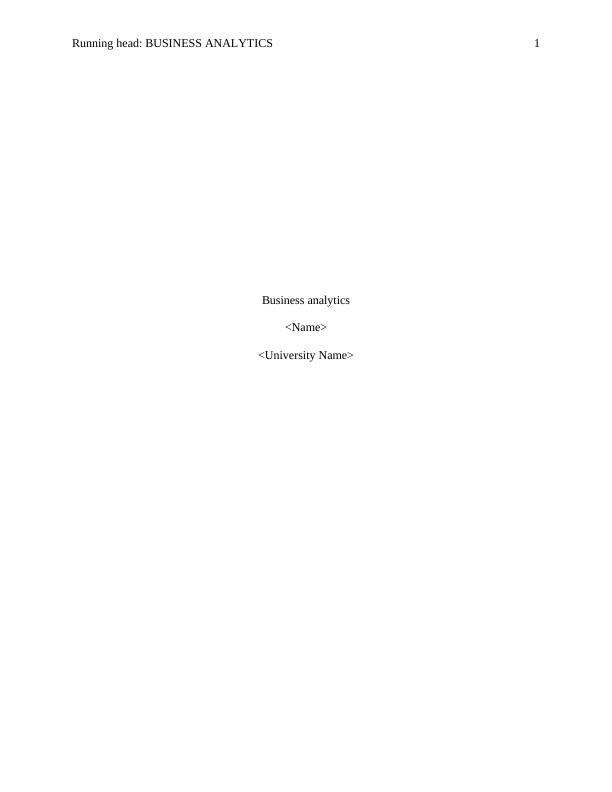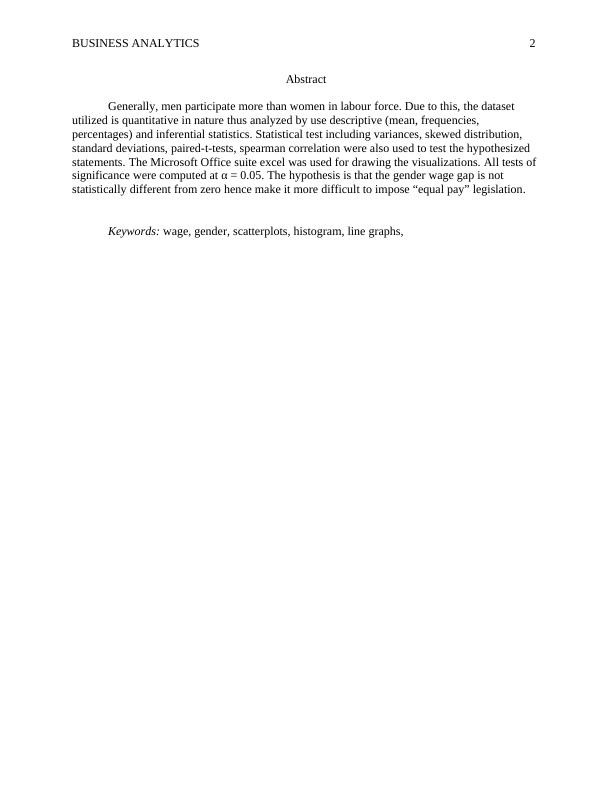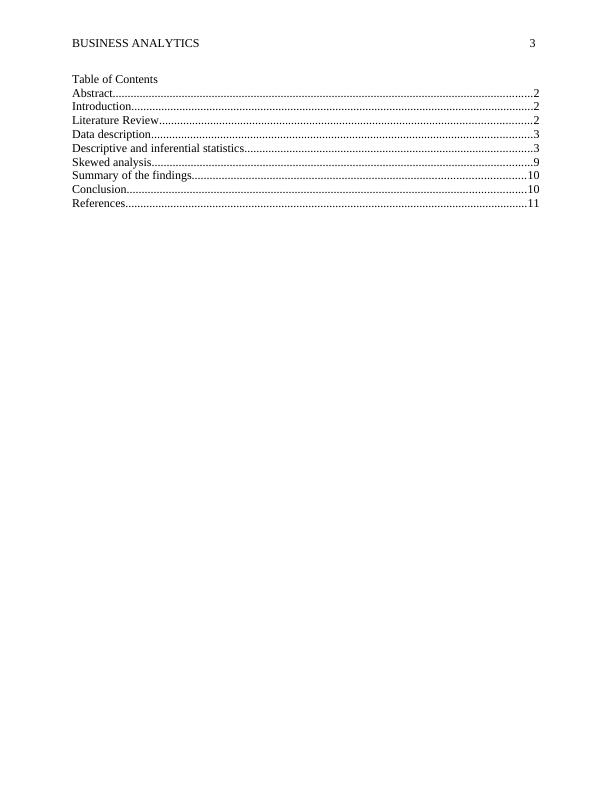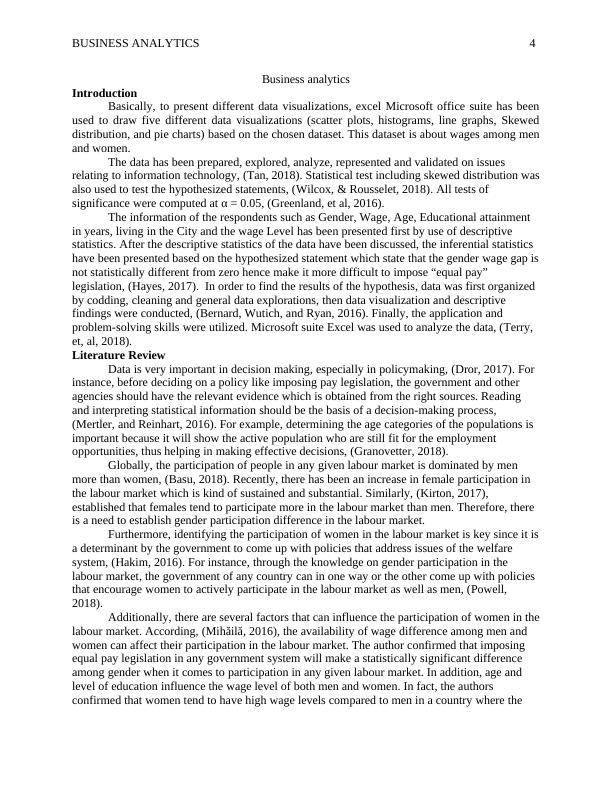Descriptive and inferential statistics
Added on 2022-09-18
12 Pages2824 Words20 Views
Running head: BUSINESS ANALYTICS 1
Business analytics
<Name>
<University Name>
Business analytics
<Name>
<University Name>

BUSINESS ANALYTICS 2
Abstract
Generally, men participate more than women in labour force. Due to this, the dataset
utilized is quantitative in nature thus analyzed by use descriptive (mean, frequencies,
percentages) and inferential statistics. Statistical test including variances, skewed distribution,
standard deviations, paired-t-tests, spearman correlation were also used to test the hypothesized
statements. The Microsoft Office suite excel was used for drawing the visualizations. All tests of
significance were computed at α = 0.05. The hypothesis is that the gender wage gap is not
statistically different from zero hence make it more difficult to impose “equal pay” legislation.
Keywords: wage, gender, scatterplots, histogram, line graphs,
Abstract
Generally, men participate more than women in labour force. Due to this, the dataset
utilized is quantitative in nature thus analyzed by use descriptive (mean, frequencies,
percentages) and inferential statistics. Statistical test including variances, skewed distribution,
standard deviations, paired-t-tests, spearman correlation were also used to test the hypothesized
statements. The Microsoft Office suite excel was used for drawing the visualizations. All tests of
significance were computed at α = 0.05. The hypothesis is that the gender wage gap is not
statistically different from zero hence make it more difficult to impose “equal pay” legislation.
Keywords: wage, gender, scatterplots, histogram, line graphs,

BUSINESS ANALYTICS 3
Table of Contents
Abstract............................................................................................................................................2
Introduction......................................................................................................................................2
Literature Review............................................................................................................................2
Data description...............................................................................................................................3
Descriptive and inferential statistics................................................................................................3
Skewed analysis...............................................................................................................................9
Summary of the findings...............................................................................................................10
Conclusion.....................................................................................................................................10
References......................................................................................................................................11
Table of Contents
Abstract............................................................................................................................................2
Introduction......................................................................................................................................2
Literature Review............................................................................................................................2
Data description...............................................................................................................................3
Descriptive and inferential statistics................................................................................................3
Skewed analysis...............................................................................................................................9
Summary of the findings...............................................................................................................10
Conclusion.....................................................................................................................................10
References......................................................................................................................................11

BUSINESS ANALYTICS 4
Business analytics
Introduction
Basically, to present different data visualizations, excel Microsoft office suite has been
used to draw five different data visualizations (scatter plots, histograms, line graphs, Skewed
distribution, and pie charts) based on the chosen dataset. This dataset is about wages among men
and women.
The data has been prepared, explored, analyze, represented and validated on issues
relating to information technology, (Tan, 2018). Statistical test including skewed distribution was
also used to test the hypothesized statements, (Wilcox, & Rousselet, 2018). All tests of
significance were computed at α = 0.05, (Greenland, et al, 2016).
The information of the respondents such as Gender, Wage, Age, Educational attainment
in years, living in the City and the wage Level has been presented first by use of descriptive
statistics. After the descriptive statistics of the data have been discussed, the inferential statistics
have been presented based on the hypothesized statement which state that the gender wage gap is
not statistically different from zero hence make it more difficult to impose “equal pay”
legislation, (Hayes, 2017). In order to find the results of the hypothesis, data was first organized
by codding, cleaning and general data explorations, then data visualization and descriptive
findings were conducted, (Bernard, Wutich, and Ryan, 2016). Finally, the application and
problem-solving skills were utilized. Microsoft suite Excel was used to analyze the data, (Terry,
et, al, 2018).
Literature Review
Data is very important in decision making, especially in policymaking, (Dror, 2017). For
instance, before deciding on a policy like imposing pay legislation, the government and other
agencies should have the relevant evidence which is obtained from the right sources. Reading
and interpreting statistical information should be the basis of a decision-making process,
(Mertler, and Reinhart, 2016). For example, determining the age categories of the populations is
important because it will show the active population who are still fit for the employment
opportunities, thus helping in making effective decisions, (Granovetter, 2018).
Globally, the participation of people in any given labour market is dominated by men
more than women, (Basu, 2018). Recently, there has been an increase in female participation in
the labour market which is kind of sustained and substantial. Similarly, (Kirton, 2017),
established that females tend to participate more in the labour market than men. Therefore, there
is a need to establish gender participation difference in the labour market.
Furthermore, identifying the participation of women in the labour market is key since it is
a determinant by the government to come up with policies that address issues of the welfare
system, (Hakim, 2016). For instance, through the knowledge on gender participation in the
labour market, the government of any country can in one way or the other come up with policies
that encourage women to actively participate in the labour market as well as men, (Powell,
2018).
Additionally, there are several factors that can influence the participation of women in the
labour market. According, (Mihăilă, 2016), the availability of wage difference among men and
women can affect their participation in the labour market. The author confirmed that imposing
equal pay legislation in any government system will make a statistically significant difference
among gender when it comes to participation in any given labour market. In addition, age and
level of education influence the wage level of both men and women. In fact, the authors
confirmed that women tend to have high wage levels compared to men in a country where the
Business analytics
Introduction
Basically, to present different data visualizations, excel Microsoft office suite has been
used to draw five different data visualizations (scatter plots, histograms, line graphs, Skewed
distribution, and pie charts) based on the chosen dataset. This dataset is about wages among men
and women.
The data has been prepared, explored, analyze, represented and validated on issues
relating to information technology, (Tan, 2018). Statistical test including skewed distribution was
also used to test the hypothesized statements, (Wilcox, & Rousselet, 2018). All tests of
significance were computed at α = 0.05, (Greenland, et al, 2016).
The information of the respondents such as Gender, Wage, Age, Educational attainment
in years, living in the City and the wage Level has been presented first by use of descriptive
statistics. After the descriptive statistics of the data have been discussed, the inferential statistics
have been presented based on the hypothesized statement which state that the gender wage gap is
not statistically different from zero hence make it more difficult to impose “equal pay”
legislation, (Hayes, 2017). In order to find the results of the hypothesis, data was first organized
by codding, cleaning and general data explorations, then data visualization and descriptive
findings were conducted, (Bernard, Wutich, and Ryan, 2016). Finally, the application and
problem-solving skills were utilized. Microsoft suite Excel was used to analyze the data, (Terry,
et, al, 2018).
Literature Review
Data is very important in decision making, especially in policymaking, (Dror, 2017). For
instance, before deciding on a policy like imposing pay legislation, the government and other
agencies should have the relevant evidence which is obtained from the right sources. Reading
and interpreting statistical information should be the basis of a decision-making process,
(Mertler, and Reinhart, 2016). For example, determining the age categories of the populations is
important because it will show the active population who are still fit for the employment
opportunities, thus helping in making effective decisions, (Granovetter, 2018).
Globally, the participation of people in any given labour market is dominated by men
more than women, (Basu, 2018). Recently, there has been an increase in female participation in
the labour market which is kind of sustained and substantial. Similarly, (Kirton, 2017),
established that females tend to participate more in the labour market than men. Therefore, there
is a need to establish gender participation difference in the labour market.
Furthermore, identifying the participation of women in the labour market is key since it is
a determinant by the government to come up with policies that address issues of the welfare
system, (Hakim, 2016). For instance, through the knowledge on gender participation in the
labour market, the government of any country can in one way or the other come up with policies
that encourage women to actively participate in the labour market as well as men, (Powell,
2018).
Additionally, there are several factors that can influence the participation of women in the
labour market. According, (Mihăilă, 2016), the availability of wage difference among men and
women can affect their participation in the labour market. The author confirmed that imposing
equal pay legislation in any government system will make a statistically significant difference
among gender when it comes to participation in any given labour market. In addition, age and
level of education influence the wage level of both men and women. In fact, the authors
confirmed that women tend to have high wage levels compared to men in a country where the

End of preview
Want to access all the pages? Upload your documents or become a member.
Related Documents
Factors affecting employee incomelg...
|28
|5343
|33
